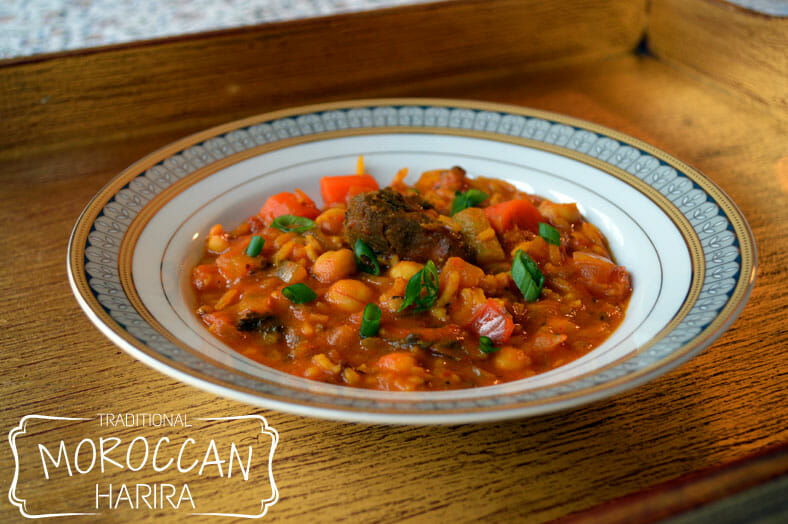Feijoada is Brazil’s undisputed national dish. A slow-cooked crock pot of black beans accentuated with hunks of salted or smoked pork, feijoada is a warming comfort food to be eaten in hot climes. Sometimes more traditional variants will go nose to tail, adding pig’s ears, feet or a tail, or, as in our case, a cut of beef.
A word once synonymous with confusion and things lacking in sophistication, feijoada has weathered several crises of image over the years to become Brazil’s darling dish: this stewy symphony of complex flavors has even inspired an actual music masterpiece, a four-part fugue by the Brazilian composer Heitor Villa-Lobos, who dedicated each quarter of his composition to one of the basic elements of the dish.

A TALE OF TWO FEIJOADAS
There are two stories about the genesis of feijoada: one that’s loved by Brazilians and deeply ingrained in their culinary consciousness, and one that’s much more likely to be true.
Folklore puts feijoada’s origins in the hands of the African slaves, who they imagined recycled the offcuts from their Portuguese masters’ kitchens: a pig’s ear here, a trotter there. They then cooked these pieces of meat in a stew of indigenous black beans, making a true hybrid creole dish with Indian, African and Portuguese contributions. This powerful image of a true national dish cobbled together from every echelon of Brazilian society is a compelling idea, but unfortunately, it’s probably not at all the case.
More likely is that the Portuguese imported the concept of a feijoada with them from the Old World. The black beans that form the basis of the dish are native to South America and were already a common local staple when the Portuguese arrived in the 16th century. The prevalence of beans in their new colony meant they were able to dampen their nostalgia for the homeland by reproducing dishes like Portuguese cozido, itself a cousin to the French cassoulet and basically a hearty bean and meat casserole that is a very convincing precursor to the feijoada.
You May Also Like…
If you love this bean stew recipe, you out to check our the Macedonian bean stew recipe we have. Or, if you love stews in general, you might want to check out some of our other popular stew recipes, such as our Moroccan Tomato and Beef Stew, Plaintains and Fish Stew from Belize, or our crab curry recipe from Mozambique.
Love soup instead of stews? Try our popular Vietnamese Pho noodle soup with brisket, or try the chicken pho version.
TROPEROS AND MINING TOWN DELICACIES
Up until the beginning of the 19th Century, Brazil was a closed-off colony where commerce with other nations was banned as was the development of any local economy. There were no universities or schools, and the colony was exclusively dedicated to mining. So strict was this mandate that the establishment of a food industry that could have diverted resources from mining (which was centered mostly around Minas Gerais) was also forbidden.
This meant that inhabitants had to look to local food supplies to feed the people working the mines (including the slaves). Black beans and manioc were pretty ubiquitous – most people had their own patch, and any new settlement quickly planted what they didn’t have – and were easy to store and preserve for travel to the mines.
Due to the distance from the mines to the ports, an industry of “carriers” started to grow in the 17th century that drove the mule and horse caravans back and forth from the mines.They brought the minerals to the ports and took back food (beans and manioc, salted meats) to the mines to feed the workers and their families. These people were called the tropeiros, and the dish attributed to them, the feijao tropeiro, a variation of feijoada that consists mainly of manioc flour, black beans, salted and cured meats and vegetables.
THE FALL AND RISE AGAIN OF FEIJOADA
Feijoada’s fortunes took a downturn in the 19th century when it was accused of facilitating yellow fever and cholera morbus in Rio de Janeiro, and began to be viewed with suspicion as to its true health benefits. A report given to the Bahia faculty of medicine at the end of the century listed a litany of woes believed to follow from over-indulgence in the likes of feijoada, including liver and kidney problems, stomach ulcers and apoplexy.
But with the eradication of Yellow Fever in the city, and following some enlightening breakthroughs in nutritional science, feijoada was let off the hook around the beginning of the 20th century, allowing it to continue its rise in the restaurants and hotels of Rio de Janeiro (which was the capital city until 1960). Traditionally, the establishments only prepared feijoada on certain days, which is why Saturday and Wednesday continue to be the hallowed days for feijoada consumption in Brazil.
ABOUT THE RECIPE
Although it’s not the prettiest dish in our arsenal, don’t let feijoada’s muddied brown palette put you off. That, or its notoriety for rambunctious passage through the digestive system. In particular, ignore the opinion of experts like the celebrated Brazilian culinary writer Luis da Camara Cascudo, who maintained that offering feijoada to foreigners would be as pointless as offering a lunch of snails and frogs to a lifelong prairie-dweller.
Instead, we invite all adventurous culinary souls to take the advice of facing feijoada with resolute anticipation and, possibly, trepidation. After all, two hundred million Brazilians can’t be wrong. Trust us on this one: we love this dish, both for its taste, and for how darn easy it is to make.
CITRUS BOOST
It’s worth noting that even though we’ve included pieces of orange in our stew, orange slices are anyway always eaten as a side with feijoada. The health benefits would include the high levels of pectin, which help with fat digestion, as well as the vitamin C which aids the absorption of iron from the beans, as well as from the other traditional side dish usually served with feijoada – collard greens.
PREPARING YOUR FEIJOADA
First off, get all of your ingredients together. Have your butcher cut the pork ribs and hock into serving sizes. Our recipe here calls for fresh rather than salted meats, as well as a mixture of beef and pork. There’s an added bit of chorizo for the spice kick.
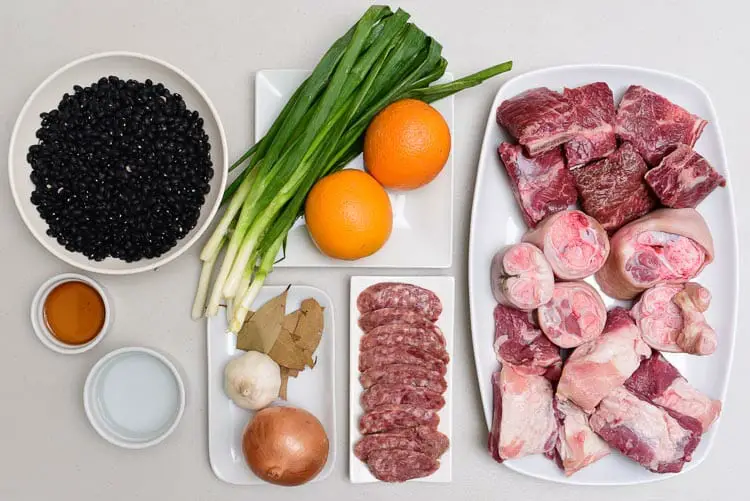
Rinse and soak the black beans for at least six hours: the longer the soak the better. If you can remember to submerge the beans the day before, this would be preferable. Many of the tummy grumbles associated with bean dishes can be eliminated by long soaking and correct preparation of the beans.
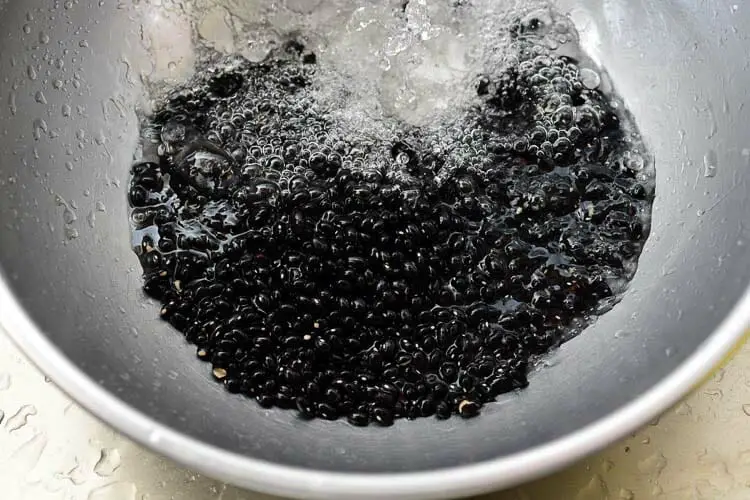
If you have the option, simplify your cooking process and put all of the ingredients (the pork ribs, pork hocks, beef brisket, chorizo, soaked beans, vodka, oranges, cilantro, green onions, and bay leaves) inside a slow cooker. Cover with just enough water to submerge all of the ingredients and set to cook for eight hours. Of course, you can do this on a stove top too, but you’ll need to keep checking liquid levels and stirring the pot to make sure nothing is sticking on the bottom.

When the stew is done, take out a cupful of black beans from the pot. Using a hand mixer or a food processor, puree the beans into a smooth paste.

Sauteé chopped onions and garlic in a pan until they’re looking golden.

Now add the black bean puree to the garlic and onions.

Stir the sautéed black bean puree back into the slow cooker pot.
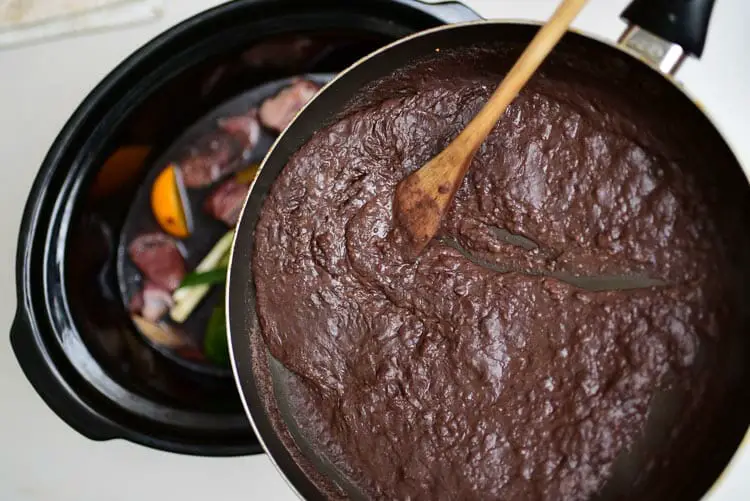
The feijoada is ready to go. Cut up some orange slices and serve with a side of sautéed collard greens or some farofa, which is sautéed and seasoned manioc flour. Finally, celebrate with a jug of cachaça or pinga, which is distilled sugar juice to add a bit of sparkle to your pork and bean feast.
Bom appetite!
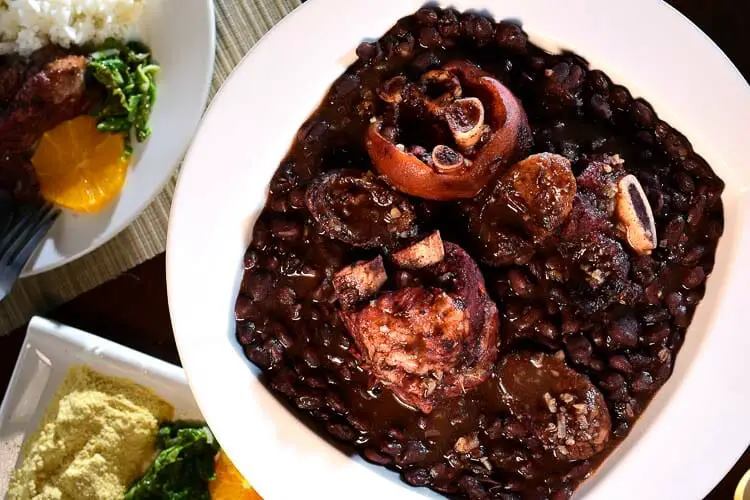
OUR TAKE ON THE RECIPE
We loved this feijoada: all the meat makes it a very rich dish, with added smokiness from the chorizo, earthiness from the black beans and a gelatinous texture from the bones and pork hocks. It’s a real meat-lover’s treat, the king of all chilis!
We made a few changes to the source recipe in the name of simplifying and speeding up the process: we decided on fresh pork and beef instead of salt-cured varieties for easier sourcing, less sodium, and less prep time (salted meats have to be soaked in water for 24 hours). Which is not to say the dish wouldn’t taste even better with the salted meat – we bet that it would. It’s just that this time we opted for ease over absolute perfection.
Some recipes call for carne-do-sol, which is basically a salt-cured beef which you could do at home should you have the time, or substitute with fresh brisket. We also skipped using pig’s tails, ears, and loin, as we figured the hocks and pork rib bones would be enough to give the stew a gelatinous substance.
We used vodka in the place of cachaça (you can use any neutral spirit) since it’s more readily available and we used olive oil as a healthier alternative to pork lard for sautéing the pureed black beans. In an attempt to cut a little more fat from the dish, we also ditched the bacon, while opting for a slow-cooker to do the job of a long slow stew for us.
One tip: don’t add salt at the beginning of the feijoada’s cook time since salt will toughen the dried beans’ outer shells resulting in the need for a much longer cooking time.
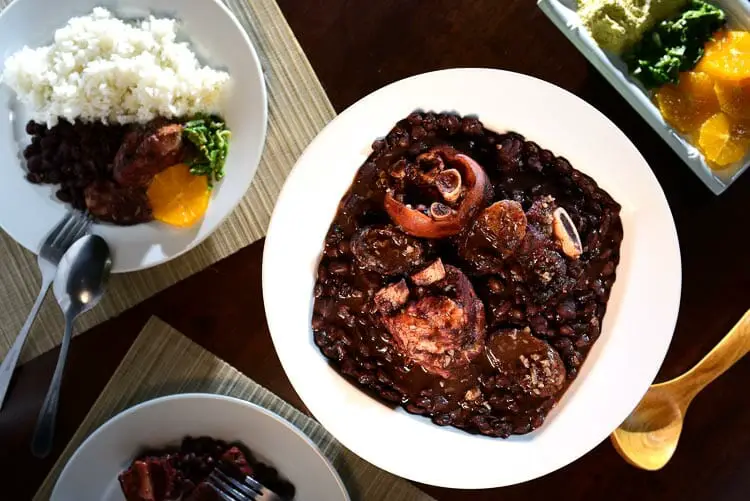
Looking to freeze stew for later? Check out our other article on how to freeze stew.
Love Stew? Try one of these other recipes:


